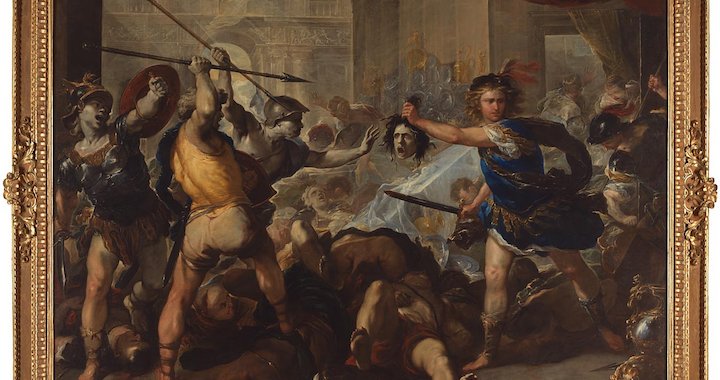
Framed
An interview with Peter Schade, the Head of the Framing department at London's National Gallery
21/02/2018
I meet Peter Schade in his office at the National Gallery, which is full of reproductions of paintings and empty frames and has the scent of freshly cut wood. After all, behind the next door is a workshop where the frames for the gallery’s paintings are made, restored, carved, cut, adjusted, painted and polished in order to complement the wonderful pieces of art themselves.
Being a woodcarver by trade, Schade is the head of the framing department at London’s National Gallery, which houses more than 2000 works of art and is the largest collection of European art in the United Kingdom. He began working at the National Gallery twelve years ago and is, in a way, responsible for how we see these iconic images on the gallery’s walls. Because a frame surrounds a whole universe of colours and figures and enhances the scenes of divine and human life depicted in a painting.

Peter Shade. © The National Gallery, London.
You once said that when you first arrived at the National Gallery, you wanted to change 80 percent of all the frames. Why?
Well, actually very few of the frames you see in the Gallery are the original ones, because the paintings have come here via many other collections, and quite often each time the painting changed ownership, its frame would have been changed as well. What we receive at the gallery is a mixture of different styles of frames and different levels of suitability for the paintings.
In the past, the Gallery’s framing department made frames instead of buying old ones, which were also replaced from time to time, because the framing department in the 1970s did not approve of the frames made in the 1950s. Later, in the 1990s, they were replaced again. We were in a situation in which we had frames replacing frames that had already been replaced. So, I thought that the most sensible way to tackle this problem would be to acquire frames from the same period as the paintings themselves. At that time, I thought that about 80 percent of the frames seen in the Gallery could be improved with better ones. The situation has improved since then, because I’ve reframed quite a lot of them – about 250 paintings (laughs).
So, your idea was that frames should be bought rather than made?
Yes, we started working with private individuals who were interested in donating money to the Gallery specifically for framing, and we got sponsorship for frame acquisitions. Through that, and also because the Gallery realised that this is something sensible to do, we have slowly and successfully built up the financial capacity to buy our frames.
Do you remember which was the first painting you reframed?
The first frame I bought for the Gallery was a small Venetian frame for Raphael’s Madonna of the Pinks (c. 1506–7), which at the time was a fairly recent acquisition. It had a very, very unsuitable frame that threw a dark shadow over the painting. I found its present Venetian frame while on holiday in Munich, in a small antique shop, and I bought it very cheaply.
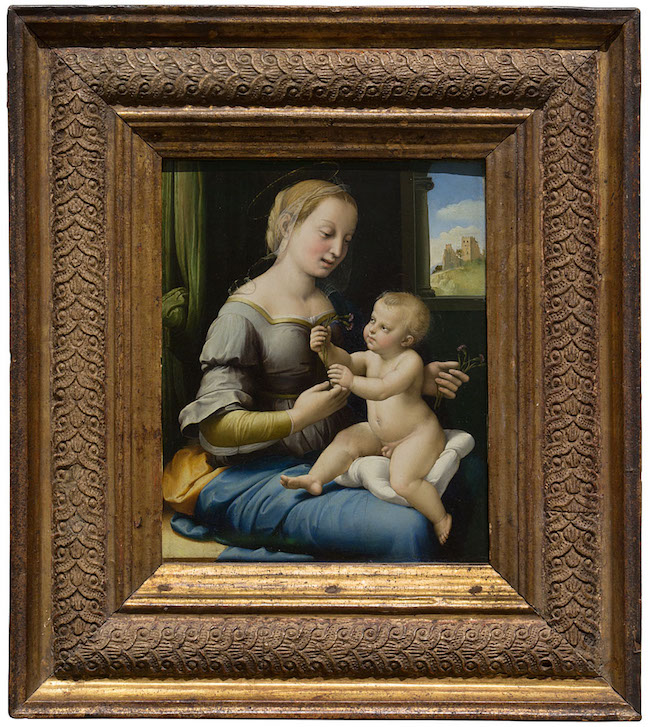
Raphael (1483 - 1520). The Madonna of the Pinks (La Madonna dei Garofani), about 1506-7. Oil on yew, 27.9 x 22.4 cm. © The National Gallery, London
How closely do you work with curators?
Quite closely. I only find frames and propose things - the curators still have to agree. Sometimes I have to spend quite a lot of time trying to convince them: some of them are very easy to deal with, but some can make it very difficult for me (laughs). Over time, I’ve worked with every department in the Gallery. The subject of frames is somewhere outside their comfort zone, because so little is known and there has not been enough research done.
In your opinion, what does a frame mean for a painting?
Originally frames were physically part of a painting. In fact, they would usually have been made first, especially in the case of 15th-century panel paintings, so that the person who prepared the wooden surface for the painter would also have carved the raised edge of the panel into a decorative moulding. Thus the frame was already in place, and the artist would have painted in the flat space inside it. There was no distinction between the painting and the frame; it was one complete object.
We have the Jacopo di Cione’s Crucifixion, a 14th century altarpiece, here in the Gallery. This, like many of our paintings, has been cleaned, probably several times over the 600 years of its existence. While cleaned, original paint still looks like old paint with gold deprived of its original varnish and slowly accumulated patina looks almost completely new or at least unbalanced. There are many examples of this in almost any collection in the world. Originally, these kinds of paintings would have been displayed in very dark churches lit only by candlelight, which would have accentuated the golden frame. It would have had a very mysterious effect and much more depth. But now, shown in a modern gallery with lots of lighting, it looks very flat. That’s always a risk when altarpieces or paintings are taken out of their original settings, where they were meant to be – in churches or chapels. That’s something I try to do with frames – I try to bring a flavour of the original setting, giving a sense of age and a sense of the place where these paintings come from. Otherwise they become kind of floating images. With the right frame, a painting becomes an object that has a history. There’s a story behind it!
I think that the most important thing frames do is to help with the illusion of space inside the painting. To me, this is the most vital function of a frame. For example, frames make the room in the painting look deeper or bigger, or they help to project portraits out into the space. They intensify whatever the artist’s intention was.
That’s why I think frames are less important in modern art, because the depiction of space is no longer the main object or the main goal of an artwork. The meaning and the concept of the art is more important than the spatial (from the word space) illusion. Frames are no longer of interest to modern artists.
Yes, it’s quite difficult to imagine, for example, Jackson Pollock’s paintings framed.
They don’t require frames because they don’t try to depict subjects or space in the way artists used to do. Also, we have to bear in mind the fact that frames have always gone together with interior design trends, with fashion and decoration, with the sense of a decorated world around us. That feeling’s not there anymore.
How does it change the viewer’s perception of a painting if the frame is wrong?
There’s an interesting story about the portrait of Doge Loredan painted by Giovanni Bellini in 1501. It’s a story about how a historically correct frame – the late-15th-century Venetian frame that this portrait has – is used incorrectly. It’s a frame suitable for paintings of the Madonna and Child, not for portraits. But the portrait of Doge Loredan has been in this frame for a long time, for around 100 years now. I have to admit it would be a problem for me to propose reframing this picture, because this is how the public is used to seeing it. The frame has become pretty much a part of the painting.
However, I think that the Doge would look much better in a different frame. With a narrower moulding he would have a greater impact on viewers than he does in the architectural altarpiece frame which is now on the painting, and which is really intended for a Biblical scene.
Yes, it’s interesting how something that went wrong at one point is still there a hundred years later because people are used to seeing it that way.
Many frame decisions are very long-lasting. Most of the things that I’ve changed were last reframed 100 or even 150 years ago, and I’m sure a good percentage of frames that I’ve bought will likewise be on these paintings for a very long time, so I try to make long-term decisions, especially when buying old frames. I’m also sure of the fact that some of the frames that I’ve changed in the Gallery will be changed later. That’s part of the learning process.
What’s important when you choose a frame for a portrait?
You want to have an impact on the room - you want to project the image into the room, which I think in early portraits is done with the help of narrow frames. Later, in the 16th and 17th centuries, portraits were framed quite elaborately because of the status of the person portrayed. They needed to have an impact on the people looking at them, they needed to look and feel important, and one way to achieve that was by having important-looking frames.
I understand that one of your sources for buying frames is your network of dealers.
Yes, and our dealers from Italy and Germany also find interesting things for us in obscure places. We actually find more interesting frames now than we did when we started. In a way, we’ve created a small market for them. Dealers now know that we’re interested, and from time to time they offer us something very interesting, so it’s become easier to find more suitable frames. But we probably might eventually find better frames for some of those we bought years ago.
The dealers you buy frames from, do you know where they get their frames?
They have their own sources and connections they use. In Italy especially it’s very important to know people who have many great contacts and who travel a lot, because it’s not that centralised. You can find really good things in quite small places. It’s not like France, where everything comes up at auctions from big Parisian dealers - in Italy you might find treasures anywhere in the country, because it was such a rich place and there were valuable things everywhere! Frames pop up in all kinds of small and unlikely places, and to have people who travel through the country and find them is really important.
What has been your biggest acquisition that you feel very proud of?
Many! But probably the most surprising one was when I found three pieces of an altarpiece of about 1480-1510, and used them to recreate the frame for Leonardo’s Madonna of the Rocks (1508). It was very surprising, because I’d never thought we’d be able to find things like that at all!
Where did you find it?
At an auction in Genoa. I was sitting in my office and looking at an online auction catalogue for a general antiques sale. It had everything imaginable, including furniture, and all completely unsorted. I was flicking through pages and pages of this online catalogue, and then suddenly I saw this: three pieces of a late 15th -early 16th century Northern Italian frame! It wasn’t an international sale, which means people wouldn’t have even have been looking for that kind of thing there. It was the kind of auction people go to when looking to furnish a house, to buy a table, a couple of chairs and plates.
At the same auction I bought the top part of the frame for Sebastiano’s The Raising of Lazarus (1517–1519). This is a monumental frame, but the painting is also monumental, and very important to the Gallery. It’s numbered NG1 – the beginning of the entire collection at the National Gallery. It was bought within the first group of paintings and given the inventory number 1.

Sebastiano del Piombo, incorporating designs by Michelangelo. The Raising of Lazarus, 1517-19. Oil on synthetic panel, transferred from wood, 381 x 289.6 cm. © The National Gallery, London
It was specifically reframed for the Michelangelo & Sebastiano exhibition held at the National Gallery last year.
Yes, the frame was made for the exhibition, and it was such a controversial thing to want to do! It wasn’t easy to convince the Gallery’s curators and directors that we should do this. But now that it’s been done, one can appreciate the painting much more. I think it works so well! The frame is in proportion with the painting and actually makes people look at it. It’s really good for the perspective, for the scale of the figures, to have such a bold architecture next to it. Very surprisingly, the original predella – the bottom part of the frame – still survives in the cathedral it was made for, so we carved an exact replica of it. We used the top from the auction sale, as I mentioned, and the columns at the sides were copied from some antique columns in our workshop.
Another really wonderful frame we bought was for the remarkable Perseus Turning Phineas to Stone (early 1680s), the most glorious painting by Luca Giordano. We bought a 17th-century Florentine frame, very beautiful and wonderfully carved, with impressive masks in the corners. It’s a very suitable frame for the painting. But it’s a stunning object! We didn’t have anything of that quality and from that time period. It looks like a fully golden frame, but actually only the highlights are painted gold, which from a distance gives it the impression that the whole thing is made of gold.
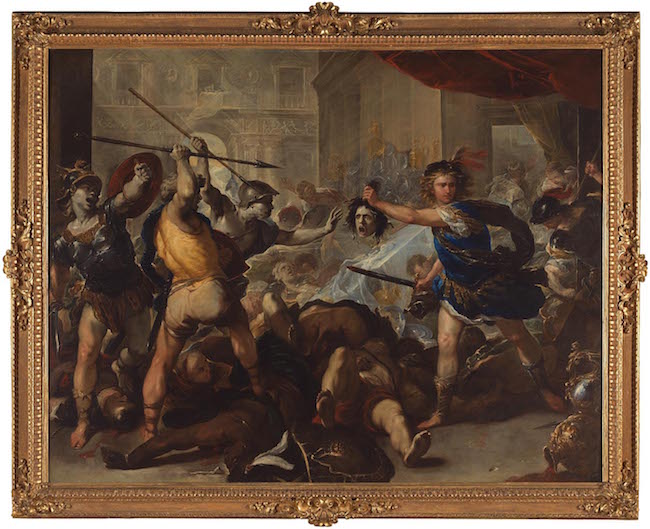
Giordano, Luca (1634 - 1705). Perseus turning Phineas and his Followers to Stone, early 1680s. Oil on canvas, 285 x 366 cm. © The National Gallery, London.

The corner of the frame for Luca Giordano’s grand painting. Photo:
Because the figures in the painting are being turned into stone, the previous frame, made in the 1970s, was silver-coloured to be in harmony with the silvery figures. But that completely flattened everything. The painting lacked vibrancy. That’s why, for me, colour matching is not the right way to choose a frame.
The problem we have here at the Gallery is that our paintings are usually too big for the frames that are available on the market. Most frame dealers buy their frames for domestic use, not for big galleries like ours, because huge frames are difficult to store. We rely on coming across appropriate frames in places where they’ve been left.
Did you buy this one in Italy as well?
Yes, via a German dealer. It came to us in four pieces. Actually in six pieces, as the two longest ones were cut in the middle to make it possible to ship them.
What is the aim you are trying to achieve when reframing a painting?
It’s to find something that would be roughly from the same period of time and from the same region as the painting, and suitable for the painting. Plus, ideally, setting the right accent within the collection. It’s not necessary to put a really important frame on a very unimportant painting. You need to keep that in mind as well – you need to have the best paintings in the most authentic frames. Creating these accents can sometimes be difficult, because you also have to look at the size of the frame available - will it roughly fit the painting or not?
The next step (ideally) should be to achieve harmony within a group of paintings in the same room. But in a place like ours, you unfortunately can’t frame several paintings in one style or think about them as being a group of paintings, because everything in the Gallery changes all the time. We lend many of our paintings to exhibitions, so there isn’t much consistency. The paintings have to perform well in different environments.
Does the history of frames go hand in hand with the development of art? Or have there been particular tastes and fashions people followed in certain times?
Yes, of course. Quite a lot of paintings, not only in the Gallery but also in this country in general, have come from French collections, since in the 18th century the French were serious connoisseurs of European art. Many of the gallery’s Dutch paintings were originally owned by major French art collectors, such as Philippe, duc d'Orléans, for example, who assembled the famous and very large Orléans Collection in his mansion in Paris.
Later, due to the French Revolution, a lot of paintings from these collections left France together with their owners, who were fleeing the revolution, and a significant number of them also ended up in England. Previously they had been located in palaces where everything was styled in the same way: the furniture, ceiling decorations, doors, everything, including the frames on the paintings. Such paintings would have been framed in elaborate 18th-century French frames.
Here in the Gallery we still have a few that come from that time. And what happened was that when these paintings arrived in England, they defined what the frame on an Old Master painting should look like. Until very recently, in fact, the 18th-century French frame was thought of as THE Old Master frame. They’re grand, very elaborate and finely carved frames, often Rococo in style, and beautifully gilded. They dominated views of how Old Master paintings should be framed and even how a museum of Old Master paintings should look. It didn’t matter whether the work in question was by a Spanish or Italian painter, or when it was painted. Huge numbers of Dutch paintings, including Rembrandt’s, were also framed in this way, although many of them would originally have been framed in dark ebony mouldings; however, dark wooden frames were considered highly unsuitable to be displayed in 18th century gilded French palaces.
When I first came to the Gallery, we only had one or two original 17th-century Dutch frames in the entire collection. Now we have more than 40. Pretty much everything was in French frames, or in 19th-century versions of French frames made to look like 18th-century ones.
At the time I started working in the picture-framing world, even the good old-fashioned frame dealers and experts favoured French frames for everything; only they insisted on using antique frames of very high quality rather than 19th-century versions. They would look for French frames with pristine 18th-century gilding. I would personally only use 18th-century French frames for 18th-century French paintings, and we don't actually have a large number of these in the gallery.
It’s interesting, because it’s really quite easy to see how Dutch paintings were framed originally. There are quite a few Dutch paintings showing interiors in which you can see paintings hanging on the walls, and a lot of these have dark frames, most likely made from ebony, or ebonised fruitwood.
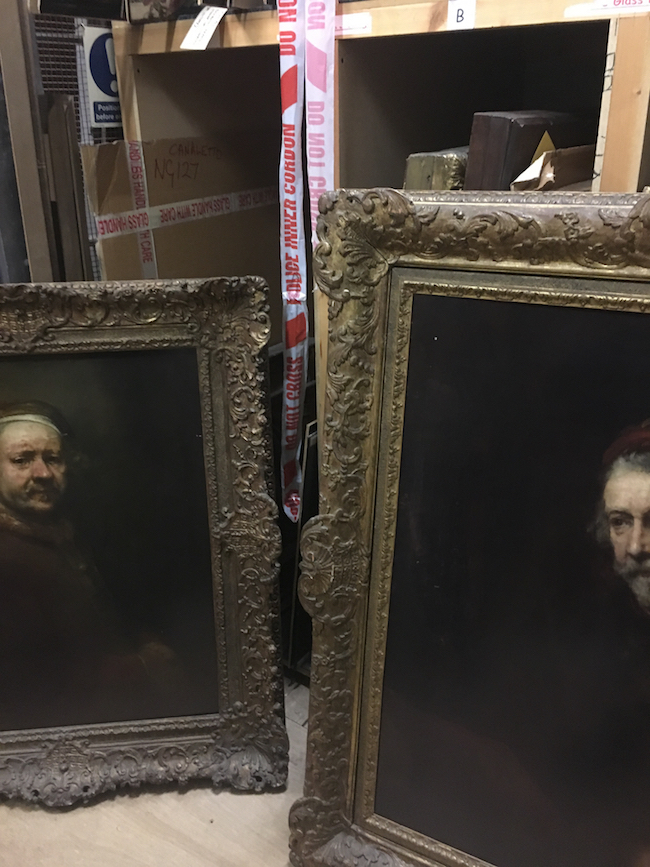
Two Rembrandt’s paintings in Framing department’s workshop before they were reframed: Self Portrait at the Age of 63 (1669) on the left and An Elderly Man as Saint Paul (probably 1669). Photo: Ilze Pole

Rembrandt’s An Elderly Man as Saint Paul in its new, dark Dutch frame on the walls of the National Gallery. Photo:
We have Rembrandt’s self-portrait here in the gallery, and it was framed in one of those French frames, making the painting look very flat. You didn’t get a sense of the figure at all, or of his arm coming forward in space. Now it's been reframed in a narrow, dark Dutch frame, which has brought the brown background to life, enhanced the feeling of space and volume in the portrait, and has altogether given the whole work a much greater impact.
We also have Rembrandt’s A Woman Bathing in a Stream (1654), which again used to be framed in an 18th-century French frame. This interfered so much with the composition that you couldn't even see her reflection in the water where she was standing! At first, our conservation team thought that this reflection was blemish on the painting, whereas it was perfectly contrived by Rembrandt himself; and now that the painting has been transferred to a very beautiful ebony frame, you can see the reflection far more clearly, and the whole composition has gained in depth.

Rembrandt (1606-1669). Portrait of Hendrickje Stoffels, probably 1654-6. Oil on canvas, 101.9 x 83.7 cm. © The National Gallery, London
On the other hand, however, we have Rembrandt’s Portrait of Hendrickje Stoffels (1654–1656) in a very high-quality 18th-century French frame, and we are probably not going to change that, even though this is a Dutch painting; the frame is so much part of the painting’s history that they belong together. Also, because the canvas size is not standard, the chances that this is the original frame are very high. It’s uncut, and it fits exactly. We haven’t had the painting here for very long, but I don’t think it’s likely that the frame has been changed. Normally, in such cases, you can see signs of adaptation, but here you can’t, and it’s very unlikely that somebody just happened to find a frame that fits so perfectly. As well as this, the gilding has such depth and brilliance, and the frame is enhanced with so many different textures - areas of cross-hatching, for instance - engraved into the surface. It’s a very elaborate, skilled work, very labour-intensive. There were specialised workshops at that time – there would have been master craftsmen executing the carving, other people re-cutting details into the layer of gesso over the carving, and then, finally, the gilders. So much expert work goes into this kind of grand-luxe 18th-century French frame.
What about Impressionist paintings? It would seem that these works of art require something very special.
The Impressionists did use some 18th-century French frames when they became wealthy enough to afford them, so, quite legitimately, you can use these same frames for Impressionist paintings. Some of the artists - Edgar Degas, for example - were very interested in frames: he made a number of drawings of frame profiles. We just framed two Degas paintings in two Degas-style frames. But the danger here that is while Degas did make these drawings, all works by him are now put into these frames, and all museums now think that their Degases have to be framed this way. I think there's a danger that this little piece of information we have gets so amplified - for instance, there are some dealers' frames, which were made for Degas's work, with his agreement.
Somewhere in Degas’ biography I read that he said he painted his frames with the same paint as his garden furniture. But nobody in museums does that! It’s interesting what art historians pick up - how one sentence becomes important and another one gets forgotten.
Even if there is documented proof of what the original frame was, we still have to frame a painting with an eye towards variety and making things look their best, rather than always follow one rigid type of design. I tend to think that this was something he just saw somewhere and made a note of it. To me it doesn’t look like an invention of a frame profile. But…these drawings have become Degas’s frames.
When you visit galleries and museums, how much attention do you pay to frames? Has it become your professional habit?
Quite often – especially in Italy, where I try to look for original frames – it’s the provincial and minor galleries that are especially interesting. That’s because the paintings there are not of such high quality, which means they haven’t changed ownership much, and it’s more likely that they have stayed in their original frames. I can learn a lot from looking at paintings of lesser quality in their original frames. The best paintings have always been a focus of attention and have often changed ownership, which also means they have been reframed according to the styles and tastes of different times. The bulk of our collection is paintings from the 16th and 17th centuries, and they’ve unfortunately lost their original frames.
As there are forged paintings, are there also forged frames?
Yes, yes, there are! It’s actually quite interesting. Sometimes not the whole frame, but just a part of it has been, let’s say... imitated. Some years ago we examined the frames in another museum in London, and - if you looked closely and critically at them - you could see that only part of the frame was an original piece from the Renaissance. The rest of it was made in the 19th century for the tourist trade - for people who wanted to take something antique home with them - but what they were buying wasn't a genuine 16th century frame, just one or two parts which had been cleverly put together with other replica pieces to make a new frame. Now it’s quite difficult to distinguish between what’s old and what’s new, because even the new bits, which were made perhaps150 years ago, have aged.
What makes it easier for us now is that frames without paintings have fairly low value, so there’s almost no point in making elaborate fakes. For example, there is a walnut frame here in my office, which we bought for a portrait by Andrea del Sarto. For somebody to make a really, really convincing copy of that, from old wood, with all the cracks… of course, it is possible to fake something like that, but it would also be very labour-intensive, so it wouldn’t make sense for an object worth just a few thousand pounds. They’re not valuable enough.
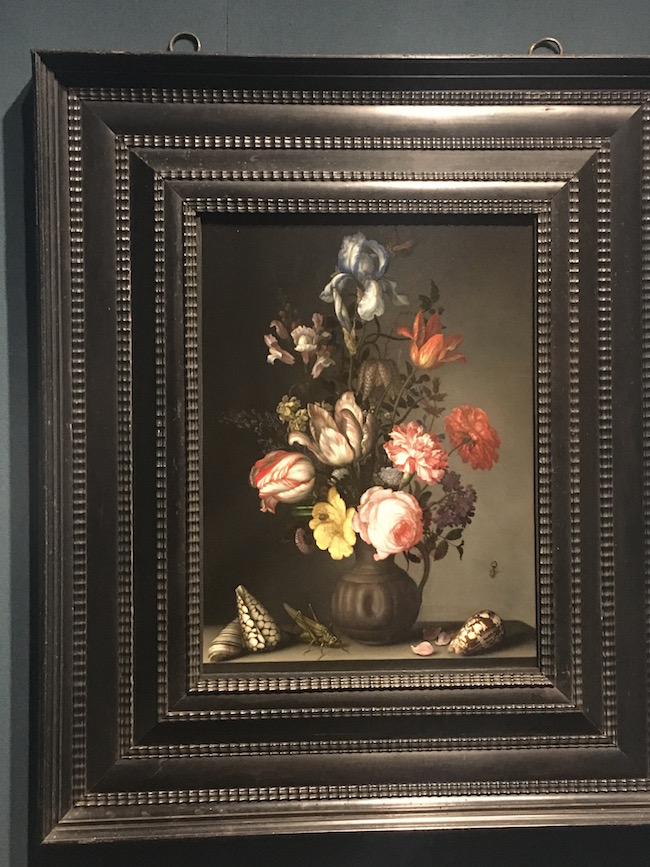
A dark ebony frame, full of detail, quality and luxury, for Flowers in a Vase with Shells and Insects by Balthasar van der Ast (c. 1630). Photo:
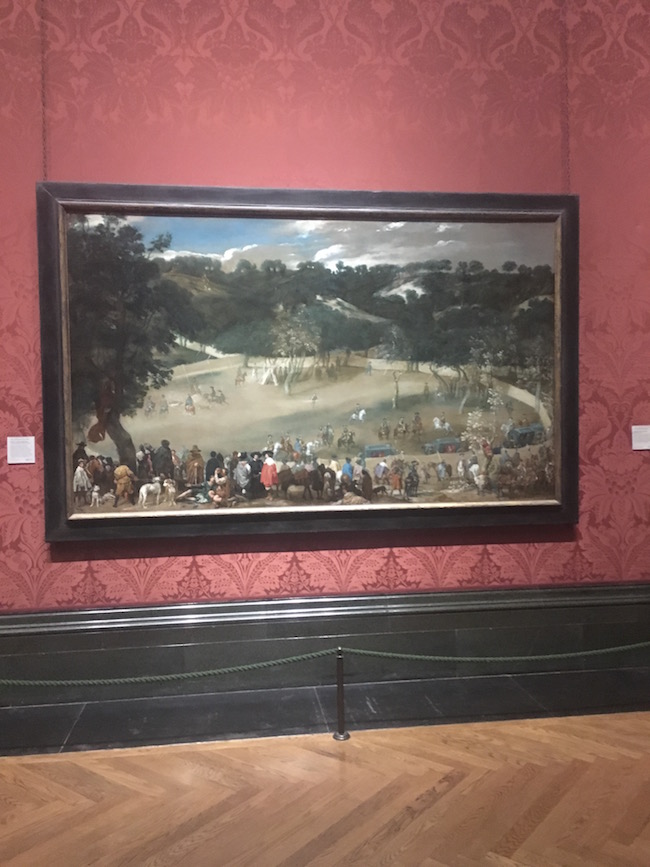
One of the first frames Peter Schade made at the National Gallery was for Diego Velázquez’s Philip IV in Brown and Silver (c.1631-2) for an exhibition of Velázquez. “It was decided to reframe this painting, and it became a case of doing something very quickly, because we didn’t have time to wait for the right frame to come along. I bought a frame, which unfortunately wasn’t big enough, but I used its centres and corners. The rest of the frame is a reproduction.” Photo:

An early-17th-century Spanish frame for The Adoration of Shepherds by an unknown Neapolitan artist (probably c. 1630). It is a so-called Herrera’ frame, originally meant to look as though it was decorated with precious stones in a variety of colours: red, dark green, blue. The painting was originally bought as a Velázquez. Now, however, experts at the Gallery tend to think it was painted by a Neapolitan artist with a very strong Spanish influence, mainly on the grounds of the woman’s dress being too revealing. Oil on canvas, 228 x 164.5 cm. © The National Gallery, London
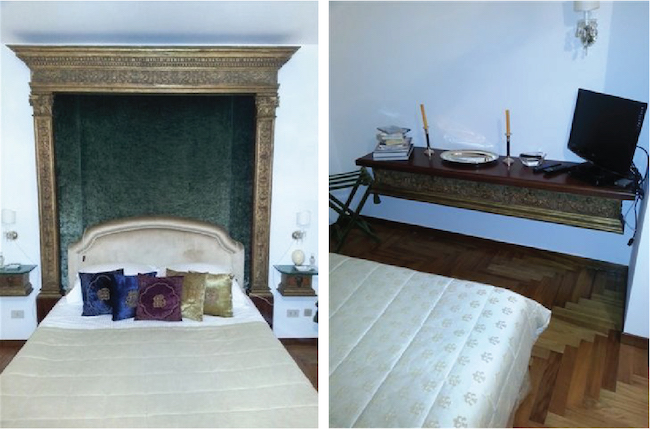

The frame for Signorelli’s The adoration of the shepherds (c.1496) is an interesting example of where and how frames get picked up by dealers. Peter Schade: “A dealer in Italy sent me a picture of a bed decorated with this frame. The owners had cut the bases of the columns and made them into bedside tables, and the predella was used as a shelf for the TV set at the end of the bed. It turned out to be a very valuable 15th century frame